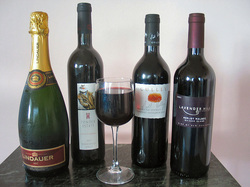New Zealand wine

New Zealand wine is largely produced in ten major wine growing regions spanning latitudes 36° to 45° South and extending 1,600 kilometres (1,000 miles). They are, from north to south Northland, Auckland, Waikato/Bay of Plenty, Gisborne, Hawke's Bay, Wellington, Nelson, Marlborough, Canterbury/Waipara and Central Otago.
History
Wine making and vine growing go back to colonial times in New Zealand. British Resident and keen oenologist James Busby was, as early as 1836, attempting to produce wine at his land in Waitangi.[1] In 1851 New Zealand's oldest existing vineyard was established by the Roman Catholic church on land in Hawke's Bay. Due to economic (the importance of animal agriculture and the protein export industry), legislative (prohibition and the temperance) and cultural factors (the overwhelming predominance of beer and spirit drinking British immigrants), wine was for many years a marginal activity in terms of economic importance.Dalmatian immigrants arriving in New Zealand at the end of the nineteenth and beginning of the twentieth century brought with them viticultural knowledge and planted vineyards in West and North Auckland. Typically, their vineyards produced sherry and port for the palates of New Zealanders of the time, and table wine for their own community.
The three factors that held back the development of the industry simultaneously underwent subtle but historic changes in the late 1960s and early 1970s. In 1973, Britain entered the European Economic Community, which required the ending of historic trade terms for New Zealand meat and dairy products. This led ultimately to a dramatic restructuring of the agricultural economy. Before this restructuring was fully implemented, diversification away from traditional protein products to products with potentially higher economic returns was explored. Vines, which produce best in low moisture and low soil fertility environments, were seen as suitable for areas that had previously been marginal pasture. The end of the 1960s saw the end of the New Zealand institution of the "six o'clock swill", where pubs were open for only an hour after the end of the working day and closed all Sunday. The same legislative reform saw the introduction of BYO (bring your own) licences for restaurants. This had a profound and unexpected effect on New Zealanders' cultural approach to wine.
Finally the late 1960s and early 1970s noted the rise of the "overseas experience," where young New Zealanders traveled and lived and worked overseas, predominantly in Europe. As a cultural phenomenon, the overseas experience predates the rise of New Zealand's premium wine industry, but by the 1960s a distinctly Kiwi (New Zealand) identity had developed and the passenger jet made the overseas experience possible for a large numbers of New Zealanders who experienced first-hand the premium wine cultures of Europe.
ReferencesExtracted from;http://en.wikipedia.org/wiki/New_Zealand_wine
The three factors that held back the development of the industry simultaneously underwent subtle but historic changes in the late 1960s and early 1970s. In 1973, Britain entered the European Economic Community, which required the ending of historic trade terms for New Zealand meat and dairy products. This led ultimately to a dramatic restructuring of the agricultural economy. Before this restructuring was fully implemented, diversification away from traditional protein products to products with potentially higher economic returns was explored. Vines, which produce best in low moisture and low soil fertility environments, were seen as suitable for areas that had previously been marginal pasture. The end of the 1960s saw the end of the New Zealand institution of the "six o'clock swill", where pubs were open for only an hour after the end of the working day and closed all Sunday. The same legislative reform saw the introduction of BYO (bring your own) licences for restaurants. This had a profound and unexpected effect on New Zealanders' cultural approach to wine.
Finally the late 1960s and early 1970s noted the rise of the "overseas experience," where young New Zealanders traveled and lived and worked overseas, predominantly in Europe. As a cultural phenomenon, the overseas experience predates the rise of New Zealand's premium wine industry, but by the 1960s a distinctly Kiwi (New Zealand) identity had developed and the passenger jet made the overseas experience possible for a large numbers of New Zealanders who experienced first-hand the premium wine cultures of Europe.
ReferencesExtracted from;http://en.wikipedia.org/wiki/New_Zealand_wine
- Oldman, Mark. Oldman's Guide to Outsmarting Wine. NY: Penguin, 2004.
- Rachman, Gideon. "The globe in a glass". The Economist, December 16, 1999.
- Sogg, Daniel. "Standout Sauvignons", Wine Spectator, November 10, 2005, p. 108-111.
- Taber, George M. Judgment of Paris: California vs France and the Historic 1976 Paris Tasting that Revolutionized Wine. NY: Scribner, 2005.
- ^ winepros.com.au. Oxford Companion to Wine. "New Zealand".
